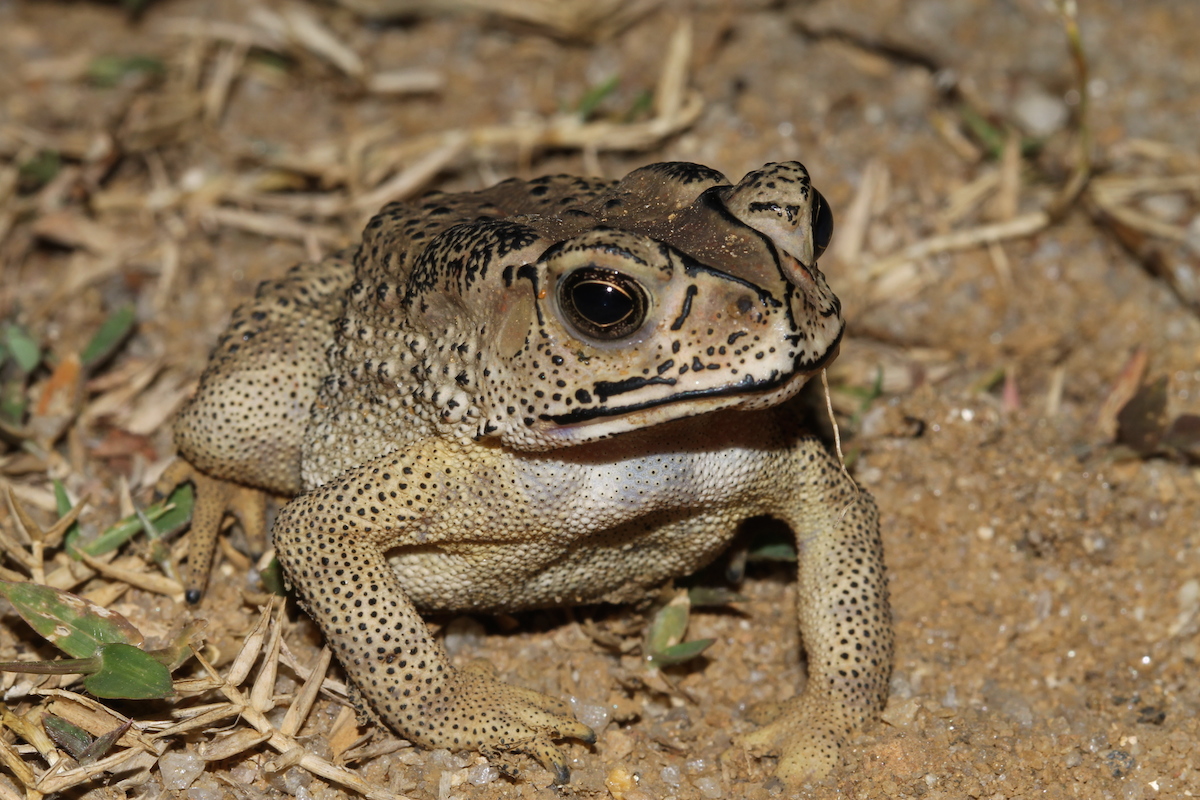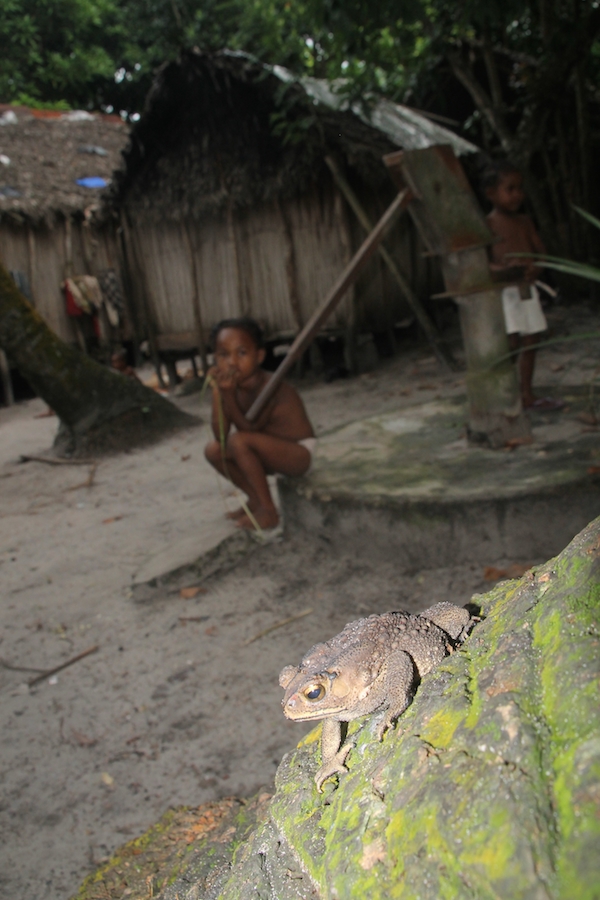- The islands of Wallacea, which include parts of Indonesia, are home to many species that exist nowhere else in the world.
- The Asian common toad (Duttaphrynus melanostictus) has spread across the islands under the conservation radar while conservationists struggle to cope with a similar invasion in Madagascar.
- If the advance of the toad across Wallacea is not stopped, scientists worry it could have devastating consequences for the world’s largest lizard, the Komodo dragon.
On the islands of Wallacea, one of the world’s hottest biodiversity hotspots, a quiet yet deadly invasion is underway. The poisonous Asian common toad’s (Duttaphrynus melanostictus) journey from island to island has left a trail of dead native species in its wake. If this island-hopping is left unchecked it could lay waste to one of the world’s last remaining ecological gems and threaten iconic species like the Komodo dragon, warn scientists in a study published in Global Change Biology.
Wallacea is a collection of thousands of islands that lie between the Asian mainland and Australia, including Indonesia’s Sulawesi, the Komodo islands and the Moluccas (or the Spice Islands). Around 40 percent of the birds and 65 percent of the amphibians of Wallacea are not found anywhere else, with some species found only on single islands, according to the Critical Ecosystem Partnership Fund.
Most of the islands don’t have native toads, says Sean Reilly, lead author of the study. That’s why the Asian common toad’s invasion is such a problem. The invasive toad is toxic, packing its poison into two glands behind its eyes; when pressure is applied to them, a thick, creamy goop oozes out. Native species that haven’t co-evolved with the toads can succumb to this poison pretty quickly, Reilly said.

While conducting the study, Reilly and his team visited affected parts of Wallacea. He described a hellish vision of islands swarming with toads: “some places they were so thick that you’d basically be walking on them.” Reilly said he came across native species like cobras dead with toads in their mouths or stomachs, and witnessed an Asian water monitor staggering around “looking drunk.” It’d probably just eaten a toad.
In addition to killing islands’ native predators with its toxin, Reilly said the toads are themselves predating smaller animals since they eat anything that’ll fit in their mouths, including small reptiles and other amphibians.
“All the native frogs were either gone or really hard to find, whereas there’d be toads and toadlets everywhere,” Reilly said.
Destination Madagascar
Wallacea isn’t the first region ravaged by invasive Asian common toads. Sometime between 2007 and 2010, a boat from Cambodia or southern Vietnam is thought to have docked at a port in Madagascar with an unexpected and unwanted guest. However, it wasn’t until December 2013 that the toad’s presence was noticed.
A few months after the toad was discovered, a group of 11 scientists published a letter in the journal Nature warning of “ecological disaster” if the toads weren’t quickly eradicated.

But eradicated it wasn’t. Since 2014, its range in Madagascar has more than doubled to around 440 square kilometres (170 square miles) in March of this year, according to the Madagascar Fauna and Flora Group (MFFG). The latest estimates put the number of toads at around 21 million.
“The issue in Madagascar has received a lot of media coverage and interest from the conservation community but nothing effective has been able to be done on the ground to halt the advance of the toad,” said MFFG research director Karen Freeman.
“There is an increasingly smaller window of opportunity to contain the toad,” Freeman added.
Toad toxin: A dragon’s bane
While scientists, conservationists and the media continue to wage an ineffectual war on the invasive toad in Madagascar, it’s quietly hopped across the eastern islands of Wallacea largely unhindered and unnoticed.
The Wallacean invasion began some time ago. Scientists believe toads showed up in Bali in 1958; in the 60s or 70s they arrived on the island of Lombok and the first record of them on Sulawesi dates from 1974. Reilly says much of the recent expansion probably occurred in the last decade or two. Just like on Madagascar, the prevailing hypothesis is that they moved by boat.
“We saw toads on ferries [that move between islands] multiple times.” Reilly recalled. “It’s really surprising that they aren’t on every single island.”
He’s concerned that if action isn’t taken now the toad could soon reach the islands of Komodo, Rinca and Flores – home of the world’s largest lizard, the Komodo dragon (Varanus komodoensis). Already the toads have been seen on the islands of Sumbawa and Sumba, which lie directly to the west and south of the dragon’s islands. Their arrival in Komodo territory could be imminent.
The Komodo dragon is a rare example of a conservation success story. Komodo National Park, which spans 29 islands, has kept their populations stable, aided by its attraction as a popular tourist destination.

Komodo dragons are renowned for their particularly gruesome killing technique. They bite down on large-bodied prey like water buffalo and slowly kill their victim through a combination of blood loss and shock. Venom may also play a role, but scientists are divided about the effects and nature of toxic proteins produced in glands of the dragon’s lower jaw.
Komodo dragons can grow to be up to three meters (nearly 10 feet) in length and weigh as much as 70 kilograms (150 pounds). However, despite their size and fearsome reputation, Reilly worries they stand to be humbled by the small Asian common toad.
“Nobody has fed one of these to a dragon, but it could be bad,” he said. While he believes the dragons would eventually wise up to the toad’s toxin and stop eating them, it’s not impossible that the toad’s arrival could wipe out entire populations on some of the smaller islands.
Eradication of the toad, if it is even possible, would be neither easy nor cheap. But Reilly claims that simply increasing vigilance at key ports could go a long way to stopping its advance. He pointed specifically to the importance of keeping western Flores – the main route to the island of Komodo and a likely entry point for the toads – toad-free.
Without such interventions, Reilly and his colleagues worry the invasion could easily claim more islands and have destructive consequences for the native animals that dwell on them.
“Our findings suggest that establishment of invasive toad populations throughout the Lesser Sunda Islands and within the range of highly endemic species such as the Komodo dragon is not only possible, but likely unless specific efforts are made to prevent the further invasion of these toads throughout Wallacea,” they write in their study.
Citation:
Reilly, S. B., Wogan, G. O., Stubbs, A. L., Arida, E., Iskandar, D. T., & McGuire, J. A. (2017). Toxic Toad Invasion of Wallacea: a Biodiversity Hotspot Characterized by Extraordinary Endemism. Global Change Biology.
Banner image courtesy of Franco Andreone.
FEEDBACK: Use this form to send a message to the editor of this post. If you want to post a public comment, you can do that at the bottom of the page.
